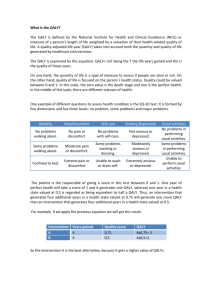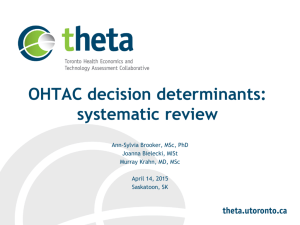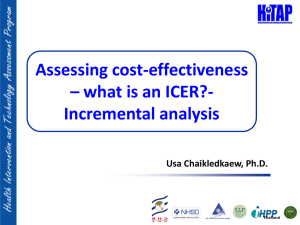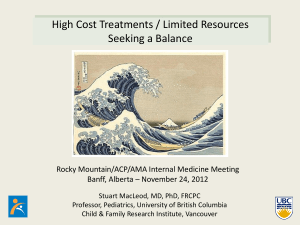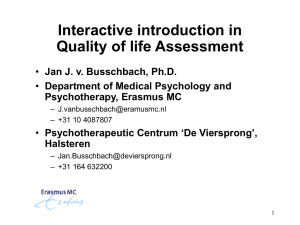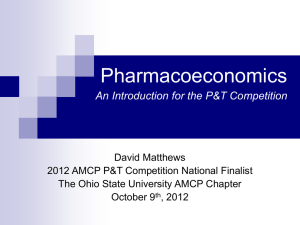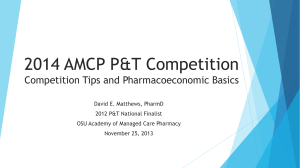Building Trust Through Rationing
advertisement
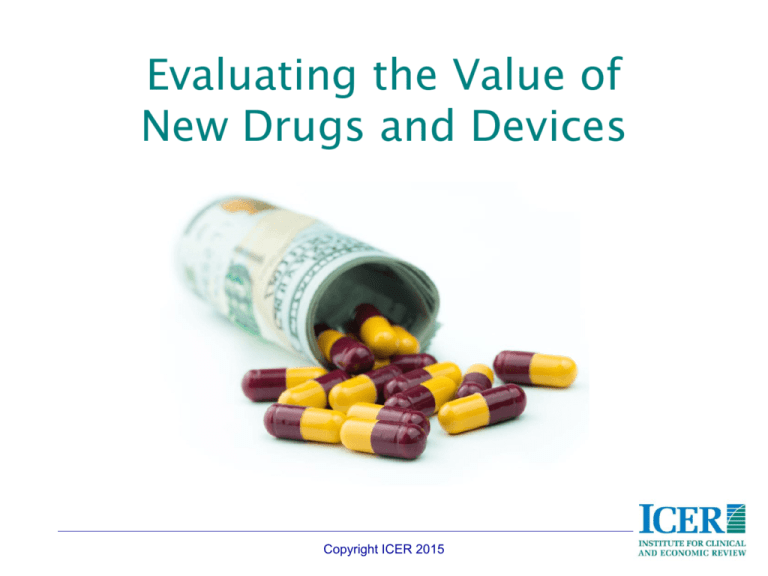
Evaluating the Value of New Drugs and Devices Copyright ICER 2015 The ICER Value Framework • The “problems” the value framework was intended to address – Poor reliability and consistency of value determinations by payers – Need for a more explicit and transparent way for HTA groups and payers to analyze and judge value • Tension between long-term and short-term perspectives • The goal – A common language and mental model of the components of value across life science companies, payers, and other stakeholders • A distinct advantage for ICER – Public HTA program “laboratories” for the application of a value framework in deliberation and voting Copyright ICER 2015 2 ICER Value Assessment Policy Development Group • NB: All participants provided input into the development of the value assessment framework but none should be assumed to approve of its approach • Insurers and Pharmacy Benefit Management Companies – – – – – – • Patient Organizations – • FamiliesUSA Physician Specialty Societies – • Aetna Wellpoint Kaiser Permanente OmedaRx Premera America’s Health Insurance Plans (AHIP) ASCO Manufacturers – – – – – – – – Merck Covidien Lilly GSK Philips Amgen National Pharmaceutical Council (NPC) Biotechnology Industry Organization Copyright ICER 2015 3 What is the Overall Structure? Copyright ICER 2015 4 A Value Assessment Flowchart Comparative Clinical Effectiveness Incremental cost per clinical outcomes achieved Other benefits or disadvantages Contextual Considerations “Care Value” Discussed and voted upon during public meetings High Intermediate Low “Care Value” Discussed and voted upon during public meetings High Intermediate Low Potential Short-Term Health System Budget Impact Provisional “Health System Value” Discussed and voted upon during public meetings High Intermediate Low Mechanisms to Maximize Health System Value Discussed during public meetings; included in final ICER reports Copyright ICER 2015 Achieved “Health System Value” Not evaluated by ICER or voted upon by public panels 5 Comparative Clinical Effectiveness Comparative Clinical Effectiveness • Incremental cost per outcomes achieved Other Benefits or Disadvantages Contextual Considerations Care Value Comparative clinical effectiveness reflects a joint judgment of the magnitude of the comparative net health benefit and the level of certainty in the evidence on net health benefit. ICER reports use ICER’s EBM matrix to describe the scientific staff’s judgment of comparative clinical effectiveness. – Judgments of the magnitude of net health benefit should consider not just average outcomes but potential significant differences in the pattern of patient response to treatment, e.g. significantly greater numbers of patients with long-term response despite overall equivalent mean response – Judgments of the level of uncertainty should take into consideration all aspects of the strength of a body of evidence as described in the ICER matrix guidebook (http://www.icer-review.org/wpcontent/uploads/2008/03/Rating-Matrix-User-Guide-FINAL-v10-22-13.pdf) Copyright ICER 2015 6 Incremental Cost per Outcomes Achieved Comparative Clinical Effectiveness Incremental Cost per Outcomes Achieved Other Benefits or Disadvantages Contextual Considerations Care Value • Incremental Cost per Outcomes Achieved – Cost per aggregated health measure (QALY) – ICER uses commonly cited cost/QALY thresholds in its guidance to its public appraisal committees • Associated with high care value <$100,000/QALY • Associated with intermediate care value $100-150K/QALY • Associated with low care value >$150,000/QALY Copyright ICER 2015 7 Other Benefits or Disadvantages Comparative Clinical Effectiveness Incremental Cost per Outcomes Achieved Other Benefits or Disadvantages Contextual Considerations Care Value • Benefits or disadvantages offered by the intervention to the individual patient, caregivers, the delivery system, other patients, or the public that would not have been considered as part of the evidence on comparative clinical effectiveness. • Examples include (but are not limited to) • The relative importance of other benefits or disadvantages in an overall determination of care value will be judged not by ICER but by one of its independent public appraisal committees – A public health benefit, e.g. reducing new infections – Treatment outcomes that reduce disparities across various patient groups – More rapid return to work or other positive effects on productivity (if not considered a benefit as part of comparative clinical effectiveness) – New mechanisms of action for treatments of clinical conditions (e.g., mental illness) that have demonstrated low rates of response to currently available treatments Copyright ICER 2015 8 Contextual Considerations Comparative Clinical Effectiveness Incremental Cost per Outcomes Achieved Other Benefits or Disadvantages Contextual Considerations Care Value • Contextual considerations include ethical, legal, or other issues that influence the relative priority of illnesses and interventions. • Specific issue to be considered: – Is there a particularly high burden/severity of illness? – Do other acceptable treatments exist? – Are other, equally or more effective treatments nearing introduction into practice? – Would other societal values accord substantially more or less priority to providing access to this treatment for this patient population? • The relative importance of contextual considerations in an overall determination of care value will be judged not by ICER but by one of its independent public appraisal committees. Copyright ICER 2015 9 Provisional Health System Value Care Value Potential Health System Budget Impact Provisional Health System Value Mechanisms to Maximize System Value Achieved Health System Value • Provisional Health System Value – Provisional health system value represents a judgment integrating consideration of the long-term care value of a new intervention with an analysis of its potential short-term budget impact if utilization is unmanaged. – If the potential budget impact of unmanaged introduction of a new intervention would contribute to an increase in overall health care costs at a trend far greater than growth in the overall national economy, health system value would be threatened. – Therefore, if the provisional health system value of a new intervention is low, manufacturers, insurers, providers, and policymakers should consider mechanisms to achieve improved health system value through changes to price, payment mechanisms, and/or patient eligibility. Copyright ICER 2015 10 Potential Budget Impact of Unmanaged Utilization Care Value • Potential Health System Budget Impact Provisional Health System Value Mechanisms to Maximize System Value Achieved Health System Value Potential Budget Impact: – Estimated net change in total health care costs over an initial 5year time-frame – Calculations will be based on broad assumptions regarding the unmanaged uptake of new interventions, i.e. without estimating potential payer or provider group actions that might modulate uptake – New interventions will be assigned to one of 4 uptake patterns – very high, high, intermediate, and low – based on consideration of 6 Rx/condition/market criteria • • • • • • Magnitude of improvement in clinical safety and/or effectiveness Patient-level burden of illness Patient preference (ease of administration) Proportion of eligible patients currently being treated Primary care vs. specialty clinician prescribing/use Presence or emergence of competing treatments of equal or superior effectiveness Copyright ICER 2015 11 Potential Budget Impact of Unmanaged Utilization Care Value Potential Health System Budget Impact Provisional Health System Value Mechanisms to Maximize System Value Achieved Health System Value • Unmanaged 5-year uptake patterns – Very high uptake pattern • 75% of eligible patients assumed to use the intervention – High uptake pattern • 50% of eligible patients assumed to use the intervention – Intermediate uptake pattern • 25% of eligible patients assumed to use the intervention – Low uptake pattern • 10% of eligible patients assumed to use the intervention Copyright ICER 2015 12 Potential Budget Impact Threshold: Drugs • Theoretical basis of the potential budget impact threshold for new drugs – • The amount of net cost increase per individual new drug that would contribute to growth in overall health care spending greater than the anticipated growth in national GDP + 1% Calculating the threshold for individual new drugs – World Bank estimates 2015-16 US GDP growth at an average of 2.75%, so GDP + 1% = 3.75% – National health care expenditures for 2014 were estimated by CMS at $3,080,100,000,000 – Contribution of drug spending in 2014 to total national health care costs = 13.3% ($409,653,300,000 out of total NHE) – If we assume that the net health care cost impact for existing drugs does not change, and allow only new drugs to account for growth in net health costs related to drugs, then all new drugs combined should not contribute to net health care cost growth more than 3.75% over current drug spending ($409,653,300,000): 3.75% x $409,653,300,000 = $15,361,998,750 – $15,361,998,750 is therefore the budget impact threshold for NET costs due to new drugs for 2015-16 – To calculate the budget impact threshold for each individual new drug, we divide the total maximum budget impact for all new drugs by the 2-year running average of the number of new drugs approved in the US. For 2013 and 2014 the average number of new drugs approved was (27 + 41) ÷ 2 = 34 – The average net budget impact threshold for each new drug can then be calculated: • Total net budget impact for all drugs of $15,361,998,750 ÷ 34 = $452 million average net budget impact per new drug – If $452 million is the average budget impact threshold, then in order to identify those new drugs whose potential budget impact is significantly higher than the average, ICER will set its potential budget impact threshold at 2x the level of the “average” drug: $452 million x 2 = $904 million NET health care cost increase. – The 2015-16 ICER threshold for NET budget impact of individual new drugs = $904 million. This figure represents net additional costs to the health care system, including cost offsets of switching from other treatments as well as any potential reductions in hospitalizations or changes in other health care costs. Copyright ICER 2015 13 Summary of Potential Budget Impact Threshold Calculations Item Parameter Estimate 3.75% Source 1 Growth in US GDP, 2015-2016 (est.) +1% 2 Total health care spending ($) 3 Contribution of drug spending to total health care spending (%) 13.3% 4 Contribution of drug spending to total health care spending ($) (Row 2 x Row 3) $410 billion Calculation 5 Annual threshold for net health care cost growth for ALL new drugs (Row 1 x Row 4) $15.4 billion Calculation 6 Average annual number of new molecular entity approvals, 2013-2014 34 FDA, 2014 7 Annual threshold for average cost growth per individual new molecular entity (Row 5 ÷ Row 6) $452 million Calculation 8 Annual threshold for estimated potential budget impact for each individual new molecular entity (doubling of Row 7) $904 million Calculation $3.08 trillion Copyright ICER 2015 World Bank, 2015 CMS NHE, 2014 CMS NHE, Altarum Institute, 2014 14 Potential Budget Impact Threshold: Devices • Theoretical basis of the potential budget impact threshold for new drugs – • The amount of net cost increase per individual new device that would contribute to growth in overall health care spending greater than the anticipated growth in national GDP + 1% Calculating the potential budget impact threshold for individual new devices – World Bank estimates 2015-16 US GDP growth at an average of 2.75%, so GDP + 1% = 3.75% – National health care expenditures for 2014 were estimated at ~$3,080,100,000,000 – Contribution of device spending in 2014 to total national health care costs ≈ 6.0% ($184,806,000,000 out of total NHE) – If we assume that the net health care cost impact for existing devices does not change, and allow only new devices to account for growth in net health costs related to devices, then all new devices combined should not contribute to net health care cost growth more than 3.75% over current device spending ($184,806,000,000): 3.75% x $184,806,000,000 = $6,930,225,000 – $6,930,225,000 is therefore the budget impact threshold for NET costs due to new devices for 2015-16 – To calculate the budget impact threshold for an individual new device, we divide the total budget impact cap for all new devices by the 2-year running average of the number of new devices approved in the US. For 2013 and 2014 the average number of new devices approved was (21 + 25) ÷ 2 = 23 – The average net budget impact threshold for each new device can then be calculated: • Total net budget impact for all devices of $6,930,225,000 ÷ 23 = $301 million average net budget impact per new device – If $301.3 million is the average budget impact threshold, then in order to identify those new devices whose potential budget impact is significantly higher than the average, ICER will set its potential budget impact threshold at 2x the level of the “average” device: $301 million x 2 = $602 million NET health care cost increase. – The 2015-16 ICER threshold for NET budget impact of individual new devices = $602 million. This figure represents net additional costs to the health care system, including cost offsets of switching from other treatments as well as any potential reductions in hospitalizations or changes in other health care costs. Copyright ICER 2015 15 Connecting care value and provisional health system value: Drugs Draft report cost/QALY estimate Significant benefits or contextual factors Probable CTAF/CEPAC Care Value votes Potential Budget Impact Probable CTAF/CEPAC Provisional Health System Value votes < $100K/QALY - sig benefits High or Intermediate < $904 million High or Intermediate < $100K/QALY - sig benefits High or Intermediate > $904 million Intermediate or Low < $100K/QALY + sig benefits High < $904 million High < $100K/QALY + sig benefits High > $904 million High, Intermediate or Low $100-150K/QALY - sig benefits Intermediate < $904 million Intermediate $100-150K/QALY - sig benefits Intermediate > $904 million Low or Intermediate $100-150K/QALY + sig benefits Intermediate or High < $904 million Intermediate or High $100-150K/QALY + sig benefits Intermediate or High > $904 million Low or Intermediate > $150K/QALY - sig benefits Low < $904 million Low > $150K/QALY - sig benefits Low > $904 million Low > $150K/QALY + sig benefits Low or Intermediate < $904 million Low or Intermediate > $150K/QALY + sig benefits Low or intermediate > $904 million Low Copyright ICER 2015 16 Connecting care value and provisional health system value: Devices Draft report cost/QALY estimate Significant benefits or contextual factors Probable CTAF/CEPAC Care Value votes Potential Budget Impact Probable CTAF/CEPAC Provisional Health System Value votes < $100K/QALY - sig benefits High or Intermediate < $602 million High or Intermediate < $100K/QALY - sig benefits High or Intermediate > $602 million Intermediate or Low < $100K/QALY + sig benefits High < $602 million High < $100K/QALY + sig benefits High > $602 million High, Intermediate or Low $100-150K/QALY - sig benefits Intermediate < $602 million Intermediate $100-150K/QALY - sig benefits Intermediate > $602 million Low or Intermediate $100-150K/QALY + sig benefits Intermediate or High < $602 million Intermediate or High $100-150K/QALY + sig benefits Intermediate or High > $602 million Low or Intermediate > $150K/QALY - sig benefits Low < $602 million Low > $150K/QALY - sig benefits Low > $602 million Low > $150K/QALY + sig benefits Low or Intermediate < $602 million Low or Intermediate > $150K/QALY + sig benefits Low or intermediate > $602 million Low Copyright ICER 2015 17 What if the Provisional Health System Value is Judged “Low”? Care Value • Potential Health System Budget Impact Provisional Health System Value Mechanisms to Maximize System Value Achieved Health System Value Maximizing health system value is an action step, ideally supported by enhanced early dialogue among manufacturers, payers, and other stakeholders. – Determine the extent to which real-world constraints in uptake will limit the actual budget impact of the new service – Decide if the expected budget impact for this service is manageable in the context of the current health care landscape – Seek savings in other areas to optimize the entire portfolio of services – Change the payment mechanism (longer terms) and/or price (lower) – Prioritize Rx populations to reduce immediate cost impact – Share the costs with government or other funders • The policy actions taken will determine the “achieved” health system value Copyright ICER 2015 18 From Value Assessment to ICER “Value-Based Price Benchmarks” • The ICER value-based price benchmark represents the price at which patients in the population being considered could be treated with reasonable longterm value at the individual patient level and with overall short-term costs to the health care system that would not be so large as to be likely to contribute to faster growth in health care spending than growth in the national economy. Copyright ICER 2015 19 From Value Assessment to Value-Based Price Benchmark: Drugs Draft report cost/QALY estimate and VBPB < $100K/QALY Draft VBPB: $100-150K/QALY (care value price range) limited by $904 million budget impact threshold if applicable Sig benefits or contextual factors as per CTAF/CEPAC Probable Care value vote Potential Budget Impact Probable Provisional health system value vote Final VBPB $100K/QALY with $904M budget impact limit if applicable - sig bens $150K/QALY with $904M budget impact limit if applicable + sig bens Copyright ICER 2015 20 From Value Assessment to Value-Based Price Benchmark: Drugs Draft report cost/QALY estimate and draft value-based price benchmark Sig benefits or contextual factors as per CTAF/CEPAC Probable CTAF/CEPAC Care value votes Potential Budget Impact - sig bens $150K/QALY with $904M budget impact limit if applicable + sig bens $100K/QALY with $904M budget impact limit if applicable $100-150K/QALY Draft VBPB: $100-150K/QALY (care value price range) limited by $904 million budget impact threshold if applicable - sig bens $150K/QALY with $904M budget impact limit if applicable + sig bens $100K/QALY with $904M budget impact limit if applicable > $150K/QALY Draft VBPB: $100-150K/QALY (care value price range) limited by $904 million budget impact threshold if applicable Final ICER valuebased price benchmark $100K/QALY with $904M budget impact limit if applicable < $100K/QALY Draft VBPB: $100-150K/QALY (care value price range) limited by $904 million budget impact threshold if applicable Probable CTAF/CEPAC Provisional Health System Value votes - sig bens $150K/QALY with $904M budget impact limit if applicable + sig bens Copyright ICER 2015 21 From Value Assessment to Value-Based Price Benchmark: Devices Draft report cost/QALY estimate and draft value-based price benchmark Sig benefits or contextual factors as per CTAF/CEPAC Probable CTAF/CEPAC Care value votes Potential Budget Impact - sig bens $150K/QALY with $602M budget impact limit if applicable + sig bens $100K/QALY with $602M budget impact limit if applicable $100-150K/QALY Draft VBPB: $100-150K/QALY (care value price range) limited by $652M budget impact limit if applicable - sig bens $150K/QALY with $602M budget impact limit if applicable + sig bens $100K/QALY with $602M budget impact limit if applicable > $150K/QALY Draft VBPB: $100-150K/QALY (care value price range) limited by $652M budget impact limit if applicable Final ICER valuebased price benchmark $100K/QALY with $602 budget impact limit if applicable < $100K/QALY Draft VBPB: $100-150K/QALY (care value price range) limited by $652M budget impact limit if applicable Probable CTAF/CEPAC Provisional Health System Value votes - sig bens $150K/QALY with $602M budget impact limit if applicable + sig bens Copyright ICER 2015 22 The ICER Value Framework Comparative Clinical Effectiveness Incremental cost per clinical outcomes achieved Other benefits or disadvantages Contextual Considerations “Care Value” Discussed and voted upon during public meetings High Intermediate Low “Care Value” Discussed and voted upon during public meetings High Intermediate Low Potential Short-term Health System Budget Impact Provisional “Health System Value” Discussed and voted upon during public meetings High Intermediate Low Mechanisms to Maximize Health System Value Discussed during public meetings; included in final ICER reports Copyright ICER 2015 Achieved “Health System Value” Not evaluated by ICER or voted upon by public panels 23

